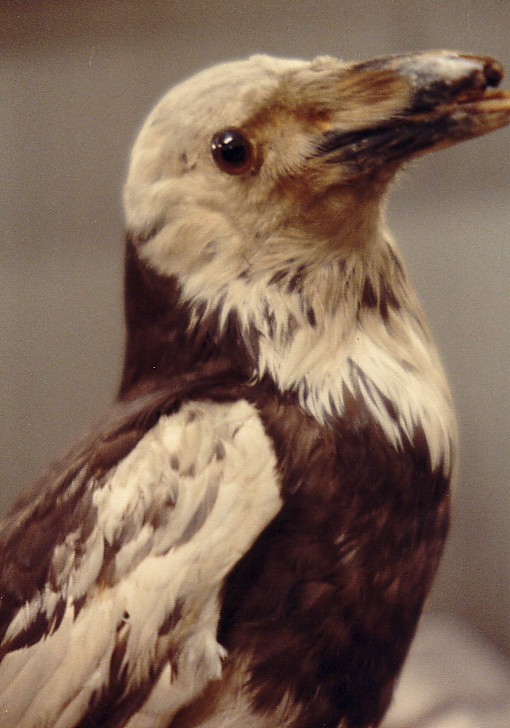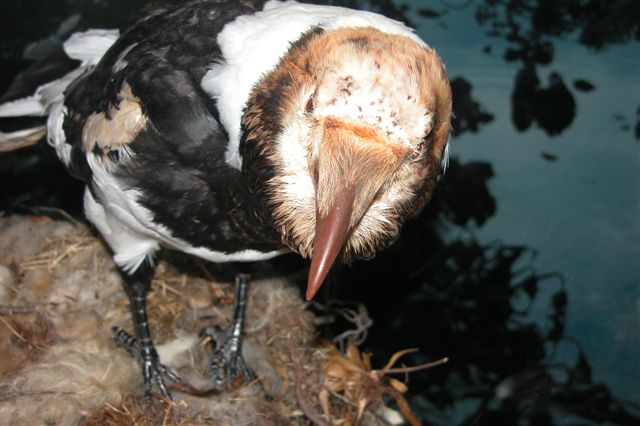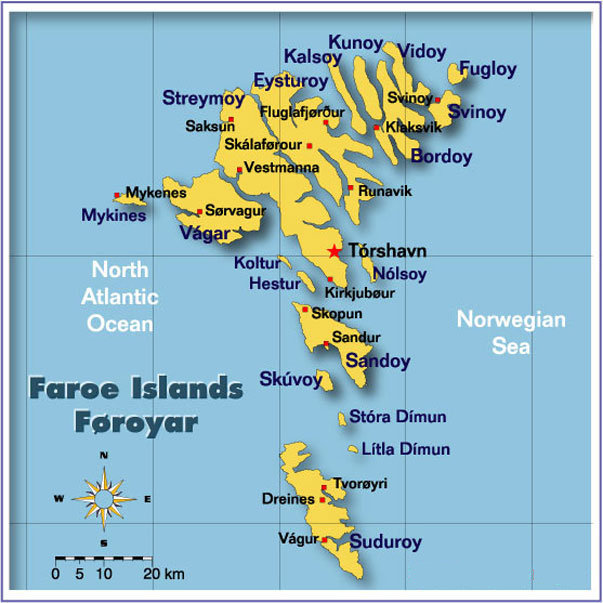Pied Faroe Raven
White-speckled mutant
Pied Raven, which previously lived in the Faroe Islands and Iceland.
The last living species were shot in 1902.
This one is photographed at the Zoo Museum, Copenhagen, May 1986.
Photo: CykelKurt
Consider this as a tribute to a beautiful bird made extinct by man in his inscrutable wisdom. The following article by Danish ornithologist and scientist Finn Salomonsen was written way back in 1935, as he travelled the Faroe Islands.
Copenhagen, January 1988
Kurt Starlit
==============================================================
==============================================================
SURVEY
Common Raven, Corvus corax corax (Linnaeus, 1758), also called Northern Raven is widespread across most of North America, Europe (including Scandinavia) and Asia.
Greenland Raven, Corvus corax principalis (Ridgway) is all black, and probably the world's largest raven.
Iceland Raven, Corvus corax islandicus (Hantsch) is all black, and roughly identical to common black Raven, though a bit larger.
Faroe Raven, Corvus corax varius (Brünnich, 1764):
English - The Faroe Raven
Faroese - Ravnur or Krunkur
Old faroese (pre 1500) - Gorpur
Corvus corax varius is less glossy than C. c. principalis or nominate corax, and intermediate in size. The bases of its neck feathers are whitish (not visible at a distance).
Pied Faroe Raven, white-speckled mutant.
English name - Pied Faroe Raven
Faroese name - Hvitravnur
Old faroese (pre 1500) - Gorpur bringu hviti
Rafn (Clausson, 1632)
Ravn (Tarnovius, 1669)
Raffn (Debes, 1673)
Bunte Ravne (Resen, 1688)
Corvus versicolor Feroensis (Worm, 1655)
Corvus Færöensis versicolor (Laverentzen, 1710)
Corvus corax varius var. leucophaeus (Brünnich, 1764)
Corvus variegatus Færøensis (Ascanius, 1767)
Corvus leucophaeus (Vieillot, 1817)
Corvus leucomelas (Wagler, 1827)
Pied Faroe Raven
White-speckled mutant
By Finn Salomonsen
Ascanius (1767, Danish edition, p.45 and poster VIII) provides the best and most detailed description, which is available of the white-speckled raven from the Faroe Islands, based partly on a number of stuffed and live birds, partly in correspondence with Faroese inhabitants. He calls it "Corvus variegatus Færøensis", thereby ignoring the name it was given three years earlier by Brünnich (Corvus corax varius var. leucophaeus). Later, the white-speckled mutant was named "Corvus leucophaeus" by Vieillot in 1817 and "Corvus leucomelas" by Wagler in 1827.
Morphological remarks
The raven on the Faroe Islands previously consisted of two forms, the normal black (C.c. varius) species, which was the most common of the two, and furthermore a white-speckled mutant, usually incorrectly designated as Corvus corax varius var. leucophaeus (Vieillot); the latter is now extinct, the last observation being made 1902.
The Faroe raven, Corvus corax varius (Brünnich) looks much like the nominate form Corvus corax corax (Linneaus), though generally speaking it is more dull colourated: not so shiny violet-blue on throat and back, and more dark green-blackish underneath. The sub-plumage - especially on the neck - is usually white, not grey as is the case with C.c. corax; proportions are like common raven, as shown in the following wing-measurements of fully grown Nordic ravens.
Scandinavia:
32 specimen, 390-445 mm (a single specimen measuring 465 mm)
Faroe Islands:
9 specimen, 400-426 mm
Iceland:
11 specimen, 410-445 mm
Greenland:
24 specimen, 430-470 mm (a single specimen measuring 480 mm)
Icelandic ravens usually have the same colouration as the Greenlandics meaning, that they cannot be destinguished from each other - C.c.islandicus (Hantsch) is identical to C.c. varius. The apparantly difference in size between islandicus and varius is due to the inadequate number of specimen available.
Hartert (1910) measures the Faroese birds to max. 440 mm, which is the same as the Icelandics. The Greenlandic birds, which should be categorized as Corvus corax principalis (Ridgway), are generally larger, but do not differ in coloration from C.c.corax.
All these forms, however, are closely related.
Corvus corax varius, white-speckled mutant
The white-speckled mutant of the Faroe raven is now extinct. This remarkable bird was well-known on the Faroe Islands in the Middle Ages. The bird was mentioned in folk-songs before 1500 AC. In the 16th, 17th and 18th century, the white-speckled raven was a rather common sight among black ravens, though it was not as numerous as the black raven.
It was mentioned by most authors, who described the Faroese bird life (Claussøn, Tarnovius, Debes, Resen, Brünnich and Svabo). It had its own Faroese name (Hvitravnur) and besides it was an appreciated curiosity at many European museums.
The bird was rather numerous in the Faroe Islands up until the beginning of the 19th century. Graba was observing more than 10 specimen in 1828, describing it as a rather common bird (Graba 1830, p.51).
Twenty years later Holm (1848, p.478) reports the bird has declined, and from middle of 19th century there is a substantial decline of white-speckled ravens.
In 1850, Wolley observes two specimen, in 1872 Feilden just one, and Kolthoff none at all (Kolthoff 1895, p.9).
Up until 1900 it had disappeared completely from Nolsø (Andersen 1898, p.355; Winge 1896, p.117) and Suderø (Winge 1897, p.310). Annandale did not see any white-speckled ravens during his visit shortly after year 1900 (Annandale 1905, p.53).
On November 2, 1902, a white-speckled raven was shot at Myggenæs (Andersen 1905, p.99). This is the last time the bird was observed.
The reason for its disappearance was a merciless persecution from man; birds were sent to Copenhagen in large numbers as a curiosity (Ascanius 1767, p.45; Holm 1848, p.478). Furthermore, the bird was bullied by crows and other birds, and - strangely enough - by black ravens (Ascanius 1767, p.45; Graba 1830, p.51; Holm 1848, p.478). Finally, its hereditary traits (genes) were recessive, so for this reason alone it could never become particularly numerous.
The white-speckled raven was not a simple albino form!
Firstly, it was known as a species of its own, having its own name, which was not the case with albinos occasionally appearing among other Faroese birds. Secondly, the plumage colour was fairly uniform in all white-speckled ravens, it was no coincidence which parts of the bird was black and which was white. This is demonstrated by many drawings and descriptions dating back to Worms and continuing up to the latest descriptions.
Completely white ravens, allegedly occurring in the Faroe Islands (Debes 1673, p.124), must either have been exceptions or maybe "real" albinos. All other authors talk about white-speckled ravens, for example Tarnovius (a contemporary to Debes) in 1669 is stating that...."white ravens not being completely white, but speckled with black feathers."
Claussøn (1632, p.152) calls them "brogede Rafne" (speckled ravens) (Resen 1688, vol.III, p.455) "bunte ravens" (pied ravens) like Ascanius, who probably has studied the largest number of white-speckled ravens, explicitly points out that there is no completely white ravens in the Faroe Islands.
Ascanius (1767), who received a large number of living as well as stuffed birds sent to Copenhagen, as well as Graba (1830) and Holm (1848), both of which have shot some specimen in the Faroe Islands, describe them as white-speckled ravens.
All descriptions are identical and the authors themselves stress that all individuals appears fairly uniform.
The same result appears from the descriptions sent to various European museums, as well as Hartert and Kleinschmidt who came to the same conclusion (1901, p.44).
Following examination of Faroese white-speckled skins at museums in London, Liverpool and Dresden, Tring and Dresser reach the following conclusion: "Tendency to partial albinism appears with fairly regular distribution on head, chest, wings and tail."
I examined one specimen myself at the London Museum, four specimen at the Zoological Museum of Copenhagen, and came to the same conclusion.
Characteristics
The Faroese, white-speckled raven has the following characteristics:
White head, rather sharply defined against a solid black or light brown-green back. White throat, transforming irregularly along the chest into a black band of varying width. White belly, however, in a small number only the middle part is white. Lesser coverts black, often with a few white feathers among. Primaries and secondaries white, wing coverts irregularly variegated, rarely quite white. Of the tail feathers, the middle pair usually are the brightest: white or white-speckled - likewise the rest, which can also be provided with a little bit of white. Only occasionally more than a few tail-feathers are white.
Such a remarkable bird naturally attracted interest. And thanks to this interest, we have found a number of interbreeding results between black and pied ravens. In this way, it was possible to detect their mutual characteristics. In the literature we find 11 incidents of interbreeding the two forms over a period of hundred years. This is quite a large number, when taking into consideration that we are talking of an extinct bird.
According to these descriptions, the Faroese white-speckled shall be considered as a mutant from the common Faroese raven, Corvus Corax varius.
Interbreeding
The decolouration is caused by a single gene which is recessive. This is in accordance with the general rules of albinistic mutation (Wriedt 1923, p.77). The heredity have two options, even though heterozygous specimen always become black, as can be expected from recessive mutation.
First generation (F1) exhibit simple Mendelian segregation. It can be disregarded whether homozygous individuals are lethal or sublethal, as the number of chicks by interbreeding usually is 4-5, which is also common among "normal" couples.
Below is shown examples of interbreeding, as indicated in the literature, and all of which support the above mentioned view. The gene of the white-speckled character is called "a". For this reason, white-speckled ravens has got the genes "aa". Black homozygous are called "AA" and heterozygous (also black) is called "Aa."
The following types of interbreeding are described in the literature:
I
Parents: AA * aa (black * white-speckled)
F1 offspring: Aa (all black)
II
Parents: Aa * Aa (black * black)
F1 offspring: AA * 2 Aa * aa (3/4 black * 1/4 white-speckled)
III
Parents: Aa * aa (black * white-speckled)
F1 offspring: Aa * aa (1/2 black * 1/2 white-speckled)
The following examples were found:
1.
Two black birds may lead to a white-speckled chick.
(Ascanius 1767, p.45); type II
2.
One often find nests with 1 white-speckled and 3 black chicks.
(Graba 1830, p.54); type II
3.
In a nest on Sandø with two black parents, each year a white-speckled chick was found among the black ones.
(Graba 1830, p.54); type II
4.
In the Dal city a black male interbred with a white-speckled female. For many years they only got black chicks, though in some years a white-speckled specimen was among the black ones.
(Graba 1830, p.54); type I og III
In the first case, the male genes are AA, in the second case, the genes are Aa.
5.
A white-speckled raven interbreeding with a black raven results in black chicks exclusively.
(Holm 1848, p.478); type I
6.
White-speckled ravens interbreeding with black ravens, will result in both black and white-speckled offspring.
(Holm 1848, p.478); type III
7. Black paired with black may result in white offspring. For example, this happened at Lejnarvatn on Strømø.
(Holm 1848, p.478); type II
8.
Two white-speckled chicks in a nest, along with black chicks.
(Wolley 1850, p.110); type III
(The parent birds are not mentioned, but must be Aa and aa).
9.
Some black couples have one, two or more white-speckled chicks.
(Müller 1862, p.10); type II
10.
One particular couple, both of whom were black, previously got one or two white-speckled chicks.
In recent years, all chicks were black.
(Müller 1862, p.10); type II
11.
In Saxen on Strømø a couple is nesting, one of which is white-speckled.
In two subsequent years it has been observed that they got 4-5 chicks, all blacks.
(Andersen 1901 a, p.242); type I
When a white-speckled interbreeds with a black, all the chicks usually turns out black (example 4, 5 and 11). This is because the chance of a white-speckled (aa) crossed with a homozygous black (AA) predominates, since the latter is likely to be more numerous than the heterozygote (Aa).
When two black heterozygotes are crossed, 1/4 of the offspring will be white. As seen from examples 1, 2, 3, 7, 9 and 10, the offspring are usually white - though some years all chicks are black (ex. 10). A few breeding pairs get two white-speckled chicks together with the blacks.As the number of eggs are usually 5, the number of white-speckled chicks corresponds quite well, with an average of 1/4 thereof.
When a black heterozygous is interbred with a white-speckled specimen, the result is an average of 2 white-speckled chicks (ex. 4, 6 and 8). With such a small number as five youngsters, one cannot expect a more specific segregation.
White or white-speckled ravens were previously considered to be widespread far beyond the borders of the Faroe Islands. For example, they seem to have been quite common on Iceland, where also Corvus corax varius breeds. Already in 1555 Olaus Magnus reports white-speckled ravens on Iceland (Magnus 1555 Liber XIX, p.117 in 1909 series), as do Ditmar Blefken in 1607 (Hantsch 1905, p.5) and Thormodus Torfæus (1715, p. 86).
Anything conclusive about the origin of Icelandic white ravens cannot be decided. Possibly it may be the same type of individual variation, known from the Faroese mutant, but there is no detailed description from that time. One gets the impression that the records are strange exceptions, rather than descriptions of a common form. This is also supported by the fact that Bjørn Jonsson (Torfæus 1715, p.86) argues that the Icelandic white-speckled raven should have come to the country on the drift-ice from Greenland ("cum glacie Grønlandica"), and therefore not breed on Iceland. But on Greenland they were also only occasionally seen (Winge 1898, p.269).
The same appears from some letters from the Icelandic bishops Skulason and Sveinsson to King Christian IV in 1647 (Hantsch 1905, p.8). One of them has only seen one white raven, the other none. In the 18th century it is not mentioned by Olaffsen and Povelsen (1772 vol.I, p.61, 220 & 548) and Faber (1822, p.5) puts it this way: "The Faroese white-speckled variety is seen no more ".
The intention of collecting and explaining this scattered information, is primarily a theoretical interest to get the genetics concerning the white-speckled raven clarified. Secondly, it is hoped that its history might create some interest, now that the bird is extinct.
LITERATURE:
Ascanius, P. 1767: "Icones Rerum Naturalium ou Figures Enluminees d'Histoire Naturelle Du Nord" (Danish edition)
Andersen, K. 1894 a: "Diomedea melanophrys, boende på Færøerne".
Scientific releases from the Natural History Society in Copenhagen, 1894.
Andersen, K. 1894 b: "Diomedea melanophrys, in the Faroe Islands".
Proceedings of the Royal Physical Society of Edinburgh, vol. XIII.
Annandale, N. 1905: "The Faroe and Iceland: Studies in island life"
Claussøn, P. 1632: "Norriges oc omliggende øers sandfærdige Bescriffuelse"
(meaning: Norway and neighboring islands truthful description)
Debes, L.J. 1672: "Rara Naturae in Insulis Ferroensibus"
Debes, L.J. 1673: "Færoae Et Færoae Reserata"
Graba, C.J. 1830: "Tagebuch gefuhrt auf einer Reise nach Faro im Jahre 1828"
(meaning: Diary written on a trip to Faroe Islands, 1828)
Holm, P.A. 1848: "Ornithologiske Bidrag til Færøernes Favna"
(meaning: Ornithological contributions to the Faroe fauna)
Naturhistorisk Tidsskrift, 2.række, vol. II, no. 5
Kolthoff, G. 1895: "Hågkomster från mitt jægarlif."
(meaning: Memorials from my life as a hunter)
Svenska Jägarforbundets Nya Tidsskrift, vol. 32-33
Müller, H.C. 1862: "Færøernes Fuglefauna og Bemærkninger om Fuglefangsten"
(meaning: Faroe bird fauna and notes on the catching of birds)
Meddelelser fra den naturhistoriske Forening i København for 1862
(meaning: Messages from the society of natural history of Copenhagen, 1862)
Olaffsen, E. & Povelsen, B. 1772: "Reise igjennem Island",
foranstaltet af Videnskabernes Sælskab i Kiøbenhavn, vol. I - II
(meaning: Journey through Iceland,
on behalf of the scientific academy of Copenhagen, volume I - II)
Winge, H. 1898: "Grønlands Fugle"
Meddelelser om Grønland, vol. XXI, afd. I
The birds of Greenland.
(meaning: Messages on Greenland, vol. XXI, subsection I)
Worm, O. 1655: "Museum Wormianum"
Wriedt, C. 1923: "Hvite farver hos pattedyr" Naturen, vol. 47
(meaning: White colours in mammals)
ref.: "The Zoology of the Faroes", vol. 3, part 2, 1935-42
==============================================================
Facts about the Faeroese white-speckled Common
Raven, Corvus corax varius
White-speckled Raven (full Danish version)
PS!
Are you in possession of any litterature concerning the white-speckled raven?
Or litterature on other corvids?
Get it published on this site!
Please mail



